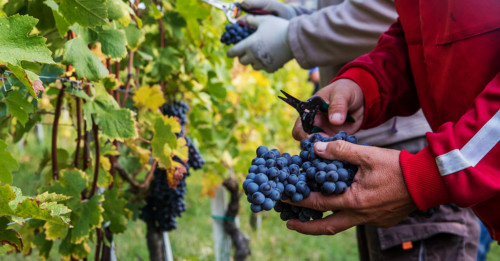Nebbiolo is an Italian red grape variety grown mainly in the mountainous region of Piedmont. The northern region is famous for DOCG wines like Barolo and Barbaresco, which are composed solely of Nebbiolo. The grape is sometimes compared to Pinot Noir because of the challenges it presents in the vineyard. It buds early yet struggles to ripen without the right amount of heat. Quality levels are also differentiated by a system similar to Burgundy’s Cru classifications.
Nebbiolo In 60 Seconds:
- Nebbiolo is a red grape variety that is native to Piedmont, Italy.
- Nebbiolo wines are often lightly-colored, yet full-bodied and highly tannic.
- Nebbiolo’s high tannin levels make it an ideal wine to age, sometimes for decades.
- In Italy, Nebbiolo is labeled by the region in which it is grown, like Barolo or Barbaresco.
What Nebbiolo Tastes Like
The full-bodied character of Nebbiolo often comes as a surprise to drinkers given the wine’s light color. As a young wine, Nebbiolo appears pale with garnet tones. It expresses red fruit aromas and flavors such as cranberry and cherry, and also has a distinct floral character with notes of rose and violet. Due to Nebbiolo’s natural high tannin levels, it can take years of bottle aging for the fruit character, acidity, and tannins of the wine to become balanced. With age, the wine develops a brick-orange hue, and reveals secondary and tertiary notes of prunes, truffle, and leather.
Differences Between Barolo and Barbaresco
The most sought-after and famous wines made using Nebbiolo are from the Barolo and Barbaresco zones, in the north-west corner of Italy. The region is home to hilly terrain, with some vineyards growing at altitudes as high as 2,000 feet above sea level. While the high altitudes can sometimes hinder ripening, in a good vintage they help produce remarkably perfumed, age-worthy wines with high acidity.
Barbaresco DOCG is the smaller of the two regions and has less stringent regulations. Barbaresco wines must age in oak for at least nine months with a total age time of two years before release. Riserva wines must age for at least four years before release. High-quality versions can age five to ten years, sometimes longer.
Barolo DOCG is nearly three times the size of Barbaresco yet still only five miles wide at its broadest point. Barolo wines must age in oak for at least 18 months with a total age time of three years before release. Riserva Barolo must age five years before being released, with high-quality versions suitable for drinking sometimes up to 20 years later.
Other Areas That Grow Nebbiolo
Nebbiolo isn’t confined to just Barbaresco and Barolo. The grape grows in more than 50 sub-regions across Piedmont. Many sub-regions, like Gattinara DOCG and Langhe Nebbiolo DOC, are home to vineyards located on less steep slopes. In these zones, Nebbiolo can be blended with other grapes, if needed. Many producers opt to make varietal Nebbiolo when possible, but also incorporate grapes such as Bonarda, Croatina, and Vespolina. Elsewhere in northern Italy, Nebbiolo is grown in the Lombardy regions of Valtellina as well as Franciacorta.
Outside of Italy, Nebbiolo can be found in parts of California’s Central Coast. While slightly less tannic, the structure and unique floral character are still evident. Producers in Australia are also gaining recognition for varietal Nebbiolo, particularly in warmer pockets like Victoria where sun and heat help the grape thrive.
What Food to Pair with Nebbiolo
After some time in a decanter, the high acidity and complex tannins make Nebbiolo a beautiful choice for pairing with food. For more successful combinations, look for foods that feature fat, butter, and olive oil to help balance the tannins. Avoid dishes that are too lean — this wine needs hearty and decadent foods to shine.
Given Nebbiolo’s heritage in northern Italy, start with rustic, Italian fare. Rich meat dishes, cheese-ridden pasta, or a creamy risotto are all great choices as the tannins bind to the food proteins and come across softer. Nebbiolo also goes surprisingly well with savory Chinese dishes and spice-driven Asian cuisines.
